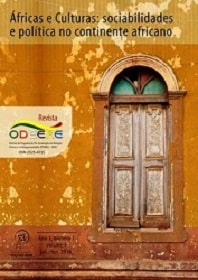"Quebra" artifacts: ethnic and aesthetic clothing from the perseverance collection
DOI:
https://doi.org/10.22481/odeere.v0i1.1540Keywords:
Clothing, Collection, Memory, PlasticityAbstract
This article reflects the debate that has been built on ethnic clothing, specifically african - Brazilian matrix. For this narrative, the theme envereda on display some artifacts belonging to the collection Perseverance: band, breastplate, helmet crown, bracelets and bags. This research selects, among the 215 pieces of collection, the adornments used in the yards of Xangôs the state of Alagoas. It is important to understand that the selected artifacts represent the memory of the "Breaking of Shango" in 1912, an act known as the invasion and destruction of all religious communities in Alagoas cities, especially the capital Maceió. Perseverance is born in this context, representing, besides the fact that originated in African culture present in the state. Therefore, the description, and then brings the dialogue between memory, representation and plasticity.
Key words: clothing, collection, memory, plasticity.
Downloads
References
ALLMAN, Jean. Fashioning Africa: power and the politics of dress. Indiana University Press: Bloomington, 2004.
ANDRADE, Fernando Antônio Gomes de. Legba: a guerra contra o xangô em 1912. Brasília: Senado Federal/Conselho Editorial, 2014.
CUNHA, Mariano Carneiro da. Arte afro-brasileira. In: ZANINI, Valter (org.) História geral da arte no Brasil. Vol II. São Paulo: Instituto Walther Moreira Salles, 1983.
ELIADE, Mircea. O sagrado e o profano: a essência das religiões. São Paulo: Martins Fontes, 1999.
GOFFMAN, Erving. A representação do eu na vida cotidiana. 14. ed. Tradução Maria Célia Santos Raposo. Petrópolis: Vozes, 2007.
LODY, Raul. Joias de Axé: fios de contra e outros adornos do corpo: a joalheria afro- brasileira. Rio de Janeiro: Bertrand Brasil, 2001.
LODY, Raul. Coleção Perseverança: um documento de xangô alagoano.Maceió:Universidade Federal de Alagoas; Rio de Janeiro: FUNARTE/Instituto Nacional do Folclore,1985.
MONTEIRO; J. FERREIRA; L. FREITAS; J. As roupas de crioula no século XIX e o traje de beca na contemporaneidade: Símbolos de identidade e memória. In: MNEME Revista de Humanidades. V. 07. N. 18, out./nov. de 2005 – p.382 -403, UFRN, Rio Grande do Norte, 2005.
MUNANGA, Kabengele & MANZOCHI, Helmy Mansur. Símbolos, poder e autoridade nas sociedades negro-africanas. In: Dédalo, Museu de Arqueologia e Etnologia/USP. São Paulo, 1987. nº 25, pp: 23-38.
NEYT, François; VANDERHAEGHE, Catherine. A arte das cortes da África negra no Brasil. In: Aguiar, Nelson (org.). In: Mostra do Redescobrimento: Arte afro-brasileira. São Paulo: Fundação Bienal, 2000.
PRANDI, Reginaldo. Segredos guardados: orixás na alma brasileira. São Paulo: Companhia das Letras, 2005.
SANTOS, Eufrazia Cristina Menezes. Religião e espetáculo: análise da dimensão espetacular das festas públicas do candomblé. São Paulo, FFLCH/USP, 2005. (Tese de Doutorado em Antropologia). https://doi.org/10.11606/t.8.2006.tde-03092007-134704
SANTOS, Juana Elbein dos. Os nagô e a morte. Petrópolis: Vozes, 1975.
SILVA, Vagner Gonçalves da. Arte Religiosa Afro-Brasileira: As múltiplas estéticas da devoção brasileira. In: Debates do Ner. Ano 9, n.13 – p.97-113, Jan/Jun. Porto Alegre, 2008.
THOMPSON, Robert Farris. The Sign of the Divine King. In: African Arts. Los Angeles, 1970.nº 3, pp: 8-17.
Downloads
Published
How to Cite
Issue
Section
License
Copyright (c) 2021 ODEERE

This work is licensed under a Creative Commons Attribution 4.0 International License.
You are free to:
Share - copy and redistribute the material in any medium or format; Adapt - remix, transform, and build from the material for any purpose, even commercially. This license is acceptable for Free Cultural Works. The licensor cannot revoke these freedoms as long as you follow the terms of the license.
Under the following terms:
Attribution - You must appropriately give credit, provide a link to the license, and indicate if any changes have been made. You may do so in any reasonable way, but not in a way that suggests that you or your use is endorsed by the licensor.
There are no additional restrictions - You cannot apply legal terms or technological measures that legally restrict others to make any use permitted by the license.














